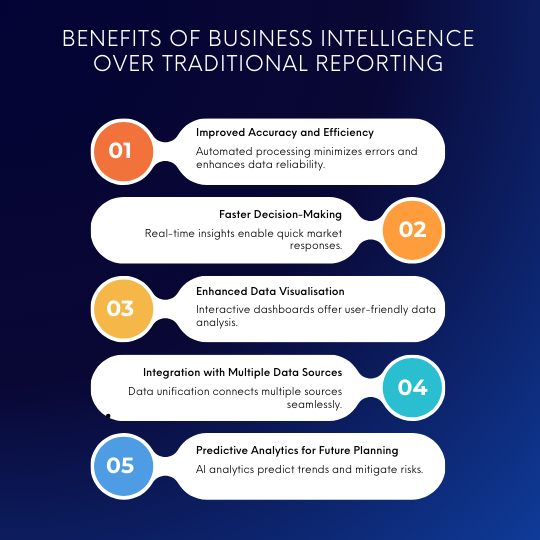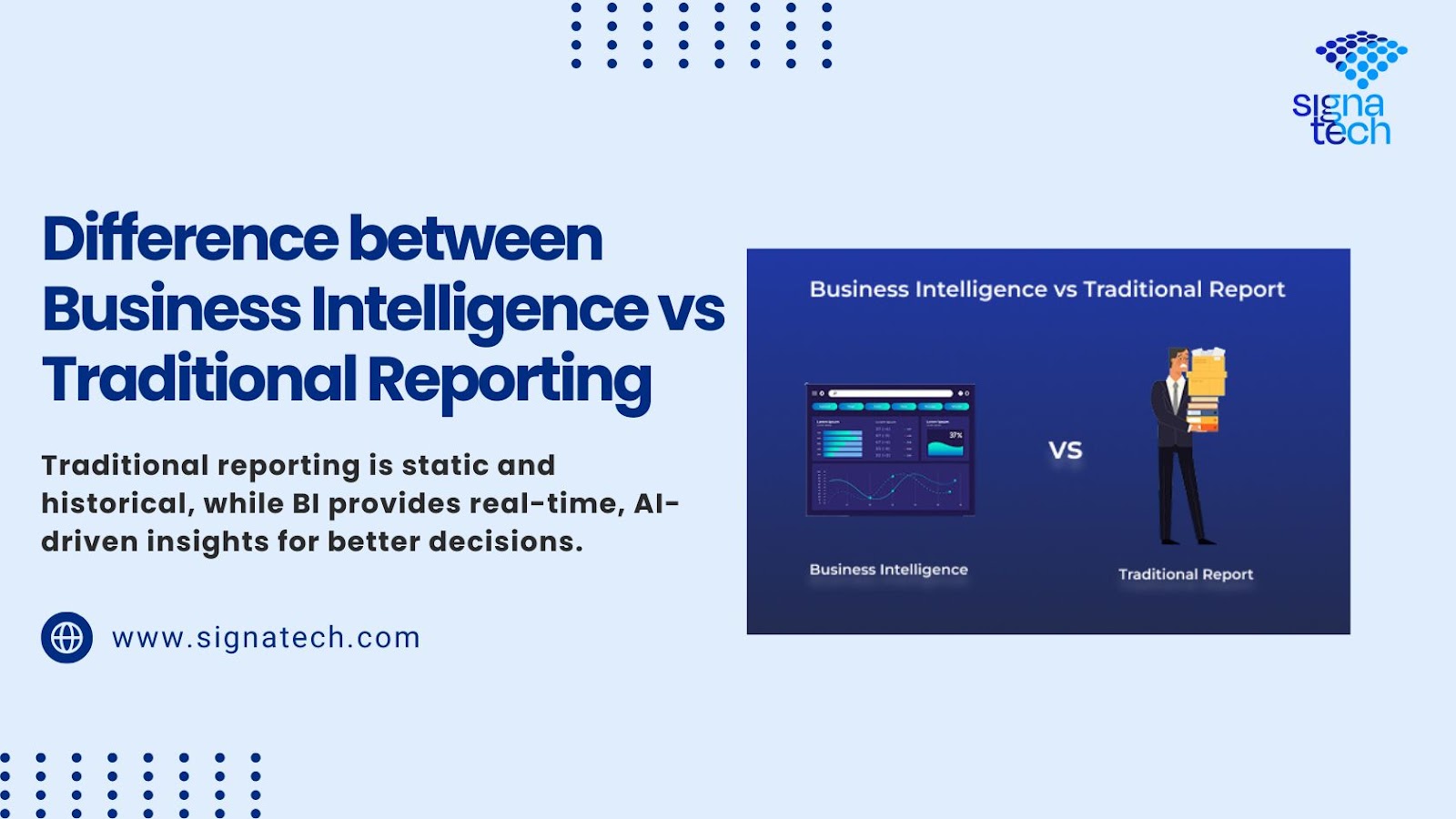The current business environment where data shapes all corporate decisions requires organizations to make decisions based on information for remaining competitive. Organisations depend on data insights to expand their operations and enhance operational effectiveness along with process optimization. Businesses have undergone significant changes in their access and analysis methods for data throughout history.
Standard reporting remains the default method for data analysis which provides periodic static reports about business performance. Business intelligence reporting tools now process data through real-time analytics while delivering interactive dashboards and predictive insights to users.
Companies need to understand the fundamental distinction between traditional reporting and business intelligence (BI) systems to achieve better operational efficiency and better decision-making. This essay investigates the essential distinctions between these approaches to help businesses choose appropriate solutions for current operational requirements.
Key Differences Between Business Intelligence and Traditional Reporting
1. Data Processing
Traditional reporting systems depend on manual data collection methods while producing fixed reports that get generated at set intervals (weekly, monthly, or quarterly). The reporting process becomes rigid because it leads to outdated information before reports receive any review.
Business intelligence reporting tools perform automated data collection while processing real-time large datasets to dynamically update dashboards. Businesses can obtain current information automatically through this system without requiring human involvement.
2. Insights and Decision-Making
Traditional reports analyze past data thus organizations must limit their responses to events from the past. The reactive nature of decision-making through this approach decreases organizational speed to respond and affects business flexibility.
BI tools deliver real-time analytics together with predictive insights which enable organizations to detect trends and anticipate challenges and make successful proactive decisions.
3. User Interaction and Accessibility
The traditional report format presents its data through spreadsheets and PDFs as static documents. Any required changes need manual handling which leads to extensive time consumption and labor.
BI platforms enable users to use interactive dashboards which allow instant access to drill down data details and view customization and instant insight extraction. These digital platforms deliver flexible options with superior user participation features.
4. Data Refresh Rate
The traditional reporting system requires programmed data update schedules that run at daily, weekly and monthly intervals. The outdated information becomes a problem because businesses require current data in real time.
BI systems operate in real-time by continuously updating data which provides users with always fresh and appropriate information.
5. Scalability and Flexibility
Businesses need IT teams to develop and update reports according to their requirements within traditional reporting systems which have strict parameters. The operations face delays and technical resources become more important due to this system’s limitations.
Businesses can produce instant reports through scalable BI tools which adapt their analytics automatically to changing requirements without needing IT support.
6. Data Sources and Integration
Traditional reporting systems use only one structured data source from either company databases or spreadsheets.
BI tools merge data from various sources which include databases alongside cloud storage and APIs and external third-party applications. Businesses can achieve better operational understanding through this capability which delivers full-scale analysis of their entire operation.
7. Visualization and Reporting Format
Basic reporting methods use tables and static charts to present data which complicates the understanding of complex trends.
BI platforms provide advanced visualization tools that include interactive graphs combined with heat maps together with AI-driven analytics which simplifies insight comprehension and action planning.
8. Automation and AI Capabilities
Creating and maintaining traditional reports demands large amounts of manual work from users.
Large datasets can be processed through BI solutions which utilize automation and artificial intelligence (AI) for pattern detection and action recommendation based on predictive analytics. The use of these tools leads to considerably better efficiency alongside higher accuracy levels.
9. Collaboration and Sharing
Traditional reports reach their audience through email distribution and printed documents which restricts both collaborative work and immediate data access.
BI tools enable stakeholders to share data in real time through their cloud-based platform and they also support role-based data sharing so everyone has access to current information at the same time.
10. Cost and Implementation
The initial investment for traditional reporting systems remains low yet the ongoing manual work creates inefficiencies that result in higher labor costs in the long run.
While BI solutions require an initial substantial investment they deliver enhanced operational efficiency together with error reduction and deliver superior ROI benefits in the long run.
Benefits of Business Intelligence Over Traditional Reporting

- Improved Accuracy and Efficiency: Automated data processing reduces human mistakes while it boosts information trustworthiness.
- Faster Decision-Making: Businesses can make rapid market responses because of real-time insights.
- Enhanced Data Visualisation: The interactive dashboard system enables users to analyze data through a user-friendly interface.
- Integration with Multiple Data Sources: Businesses achieve data unification through the connection of multiple data sources.
- Predictive Analytics for Future Planning: Organisations use AI-driven analytics to predict market trends while developing strategies for potential risks.
- Access to Business Intelligence Consulting Services: Organizations should utilize expert BI consulting services to optimize data strategies which leads to better business results.
Organisations have undergone a major change in their data-driven decision-making processes through the transition from traditional reporting to business intelligence reporting tools. BI surpasses traditional reporting methods because it delivers enhanced efficiency alongside better scalability and strategic benefits.
Businesses that use BI technology to process real-time data and generate predictive insights and automate processes using AI maintain their competitive edge in today’s market. Organisations achieve better decision-making and operational efficiency and long-term business growth through the proper selection of BI solutions.
Business Intelligence Consulting Services play a crucial role in helping organisations adopt current BI tools and implement data-driven approaches to discover new possibilities for maintaining their competitive position. You should evaluate the best solutions for business intelligence enhancement because the time to make this move is now. Signatech provides businesses with expert BI solutions that help them achieve maximum data value.
